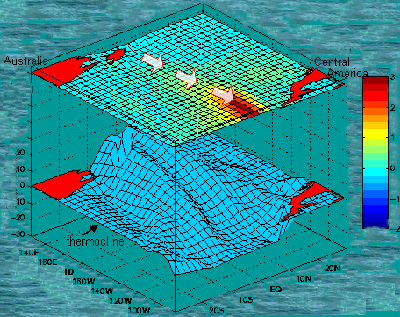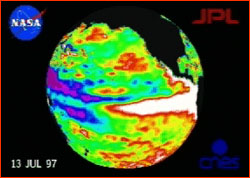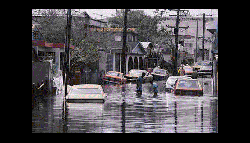


The amount of energy El Niņo amasses is as incredible as the effect it can have on the worlds climate. To equal the amount of energy in an El Niņo it would take more than a million power plants running full power for a whole year. More energy than has been consumed in the United States since the turn of the century.
The thing is no one knows for sure what causes this phenomena. There are two prominient therioes. Some scientist believe warm masses of air in the western Pacific, heated by the extreme temperatures of the tropical water, create a vaccuum beneath them as they rise. This vaccuum pulls the trade-winds in towards it. These winds increase in strength and pile up more warm water as they blow across the oceans surface. This creates more thermal updrafts, more vaccuums, and stronger winds. This cycle continues until something breaks. The winds can no longer support this wall of water it has built. Everything changes place, what was high is low and vice-versa. Water levels dip below sea-level near Australia, and rise in the east near South America.
The other theroy goes like this: Strong west-blowing winds near the equator, push against the sea. These winds drive the warmer surface water against Indonesia and Australia. These waters begin to stack up like debris in a harbour. El Niņo is born.
There are of course, other therioes some pretty complex. Out of all of this speculation there is one common element. The scientific community agrees that El Niņo is an oscillation, likened to a dog chasing its own tail.
 El Niņo scientific name is ENSO (El Niņo Southern Oscillation) the name explains the teeter-totter effect of the reverbation between two extremes. El Niņo is one extreme as it runs it's course an " anti El Niņo" called La Nina appears and El Niņo dies. East and west this cycle has run non-stop for thousands of years. El Niņo and La Nina appear about 30 times a century, with intervals as short as two years and as long as ten.
El Niņo scientific name is ENSO (El Niņo Southern Oscillation) the name explains the teeter-totter effect of the reverbation between two extremes. El Niņo is one extreme as it runs it's course an " anti El Niņo" called La Nina appears and El Niņo dies. East and west this cycle has run non-stop for thousands of years. El Niņo and La Nina appear about 30 times a century, with intervals as short as two years and as long as ten. Only a few of these appearance are as big as this on in 1997, or 1982 which was believed to be heightened by a volcanic erruption in Mexico. No one can predict effectivly which ones will reach titanic porportions. Climate science is not exact, it's all about probabilities. Scientist can predict some of the effects El Niņo may have. Such as there is a 60% chance California will be deluged, however, there is also a 10% chance it won't. The closer you are to the tropical Pacific ocean the easier it is to predict the probabilities. For instance there is a 95% chance that the Galapagos Islands will be drenched. The futher away from the tropical Pacific ocean the harder it is to predict El Niņo's effects.
Only a few of these appearance are as big as this on in 1997, or 1982 which was believed to be heightened by a volcanic erruption in Mexico. No one can predict effectivly which ones will reach titanic porportions. Climate science is not exact, it's all about probabilities. Scientist can predict some of the effects El Niņo may have. Such as there is a 60% chance California will be deluged, however, there is also a 10% chance it won't. The closer you are to the tropical Pacific ocean the easier it is to predict the probabilities. For instance there is a 95% chance that the Galapagos Islands will be drenched. The futher away from the tropical Pacific ocean the harder it is to predict El Niņo's effects.

This puddle of heat energy in the Pacific ocean affects the weather around the world. It is because of this enormous amount of energey that El Niņo's are second only to the change of seasons when it comes to shaping the earth's weather.



